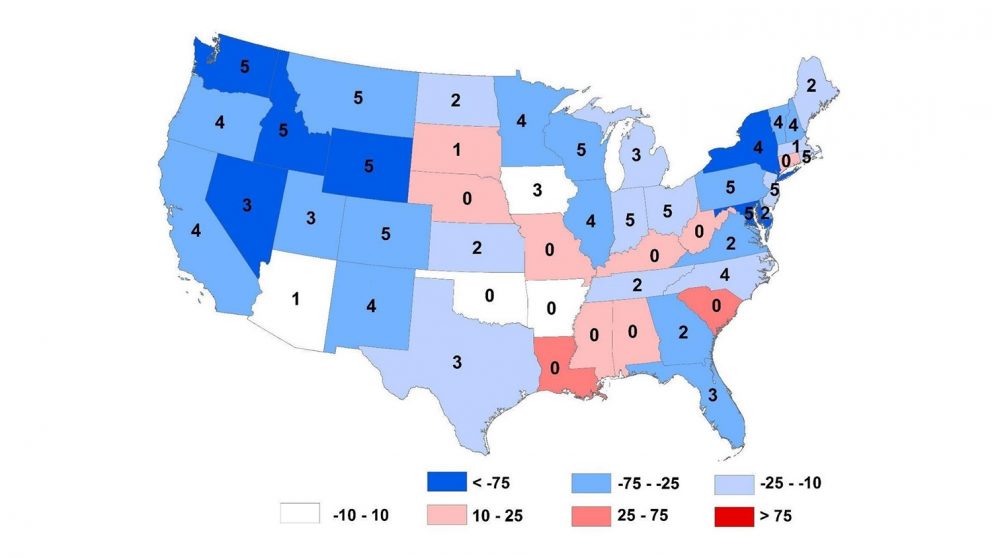Water Efficiency in Rural Areas is Getting Worse
Published on by Naizam (Nai) Jaffer, Municipal Operations Manager (Water, Wastewater, Stormwater, Roads, & Parks)

Spatio-temporal patterns of water-use efficiency (per-capita consumption) over the continental United States. Colors indicate the change in per-capita consumption, in gallons per day per person, computed as the difference between 2010 and 1985 estimates. The numbers indicate the number of 5-year periods each state reduced its per-capita withdrawals from 1985 to 2010.
A nationwide analysis of water use over the past 30 years finds that there is a disconnect between rural and urban areas, with most urban areas becoming more water efficient and most rural areas becoming less and less efficient over time.
“Understanding water use is becoming increasingly important, given that climate change is likely to have a profound impact on the availability of water supplies,” says Sankar Arumugam, lead author of a paper on the work. “This research helps us identify those areas that need the most help, and highlights the types of action that may be best suited to helping those areas.” Arumugam is a University Faculty Scholar and professor of civil, construction and environmental engineering at North Carolina State University.
The new paper stems from a National Science Foundation-funded, interuniversity research project which focuses on understanding how water sustainability in the United States has changed over the past 30 years as a result of climate change and population growth.
For this paper, researchers evaluated water use data at the state and county level for the 48 contiguous states. Specifically, the researchers looked at water-use efficiency, measured as per capita consumption, in 5-year increments, from 1985 to 2010.
“This is the first systematic evaluation of water use across the continental U.S.,” Arumugam says. “And we found that some states – including Washington, Pennsylvania and Wyoming – were becoming more efficient every five years. Meanwhile, other states – such as South Carolina, Oklahoma and Mississippi – have gotten worse every five years.”
But a look at the county-level data reveals what may be the most important finding: most rural counties are getting less efficient, while most urban counties are getting more efficient.
“In other words, as we are facing a more uncertain future regarding water resources, rural counties are being left behind,” Arumugam says.
The researchers found that investment in new water-efficiency technologies, and retrofitting existing water infrastructure, are big reasons for the improvement in urban areas.
“Rural counties appear to lack the resources, the political will, or both, to keep pace,” Arumugam says.
Another important finding is that technologies and strategies focused on efficiency – as opposed to large-scale projects, such as building new reservoirs – have been extremely successful. These efforts have allowed urban areas to avoid sharp increases in water use, even as their populations have grown significantly.
“There may be a role for huge infrastructure projects at some point, but these findings underscore the value of focusing on efficiency measures – and the need to pursue those measures in rural counties,” Arumugam says.
The paper, “Synthesis of Public Water Supply Use in the U.S.: Spatio-temporal Patterns and Socio-Economic Controls,” is published in the American Geophysical Union open-access journal Earth’s Future . The paper was co-authored by S.B. Seo, R. Bhowmik, G. Mahinthakumar, and E.Z. Berglund of NC State; K. Kunkel of the Cooperative Institute of Satellites and Climate at NC State; J.L. Sabo, K.L. Larson and A. Ruhi Vidal of Arizona State University; T. Sinha of Texas A&M University; and J. Kominoski of Florida International University. The work was done with funding from NSF’s Water Sustainability and Climate program under grant number 1204368.
-shipman-
Note to Editors: The study abstract follows.
“Synthesis of Public Water Supply Use in the U.S.: Spatio-temporal Patterns and Socio-Economic Controls”
Authors : A. Sankarasubramanian, S.B. Seo, R. Bhowmik, G. Mahinthakumar and E.Z. Berglund, North Carolina State University; J.L. Sabo and K.L. Larson, Arizona State University; T. Sinha, Texas A&M University; K. Kunkel, Cooperative Institute of Satellites and Climate, North Carolina State University; J. Kominoski, Florida International University
Published : May 18, Earth’s Future
DOI : 10.1002/2016EF000511
Abstract: Recent USGS water use reports suggest that increasing water-use efficiency could mitigate the supply-and-demand imbalance arising from changing climate and growing population. However, this rich data has not been analyzed to understand the underlying patterns, nor have they been investigated to identify the factors contributing to this increased efficiency. A national-scale synthesis of public supply withdrawals (“withdrawals”) reveals a strong North-South gradient in public supply water use with the increasing population in the South contributing to increased withdrawal. Contrastingly, a reverse South-North gradient exists in per-capita withdrawals (“efficiency”), with northern states consistently improving the efficiency, while the southern states’ efficiency declined. Our analyses of spatial patterns of per-capita withdrawals further demonstrate that urban counties exhibit improved efficiency over rural counties. Improved efficiency is also demonstrated over high-income and well-educated counties. Given the potential implications of the findings in developing long-term water conservation measures (i.e., increasing block rates), we argue the need for frequent updates, perhaps monthly to annual, of water use data for identifying effective strategies that control the water-use efficiency in various geographic settings under a changing climate.
Attached link
https://news.ncsu.edu/2017/05/nationwide-water-efficiency-2017/Taxonomy
- Water Efficiency
- Conservation
- Consumption
- Efficiency Improvement